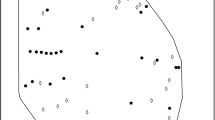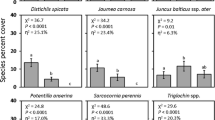Abstract
The hydrogeomorphic (HGM) approach to wetland assessment was combined with the Environmental Monitoring and Assessment Program (EMAP) survey design procedures to evaluate the condition of non-tidal riverine and flats wetlands in the Nanticoke River watershed (Delaware and Maryland, USA). We found degradation of wetland functions below reference standard levels for the majority of wetlands in both classes. Wetland condition was also related to the level of disturbance in both wetland classes. In flats, the most common disturbances were associated with hydrologic and vegetation modifications. Flat wetlands with low HGM function scores for the Plant Community and Habitat functions had almost all been converted from hardwood forest to Loblolly pine plantations. Most modifications associated with riverine wetlands were associated with stream channelization. Results of this study demonstrate that a site-specific and reference-based approach to assessment (i.e., the HGM method) can successfully be applied at the scale of an entire watershed if it is combined with a sampling approach that allows sites to be selected without geographic bias. The approach can also be used to determine if wetland functions vary from one sub-basin to another, and results of this project can be used by managers to begin to develop strategies for restoration of wetland functions at the watershed scale.
Similar content being viewed by others
Literature Cited
Abbruzzese, B. and S. Leibowitz. 1997. A synoptic approach for assessing cumulative impacts to wetlands. Environmental Management 21: 457–75.
Bartoldus, C. C. 1999. A Comprehensive Review of Wetland Assessment Procedures: A Guide for Wetland Practitioners. Environmental Concern, St. Michaels, MD, USA.
Bedford, B. 1996. The need to define hydrologic equivalence at the landscape scale for freshwater wetland mitigation. Ecological Applications 6: 241–51.
Brinson, M. M., F. R. Hauer, L. C. Lee, W. L. Nutter, R. D. Rheinhardt, R. D. Smith, and D. Whigham. 1995. A Guidebook for Application of Hydrogeomorphic Assessments to Riverine Wetlands. U.S. Army Corps of Engineers, Waterways Experiment Station, Vicksburg, MS, USA. Technical Report WRP-DE-11.
Brooks, R. P., D. Heller Wardrop, and J. A. Bishop. 2004. Assessing wetland condition on a watershed basis in the Mid-Atlantic region using synoptic land cover maps. Environmental Monitoring and Assessment 94: 9–22.
Cormier, S. M., M. Smith, S. Norton, and T. Neiheisel. 2000. Assessing ecological risk in watersheds: a case study of problem formulation in the Big Darby Creek watershed, Ohio, USA. Environmental Toxicology and Chemistry 19: 1082–96.
Dalenius, T., J. Hájek, and S. Zubrzycki. 1961. On plane sampling and related geometrical problems. Proceedings of the 4th Berkeley Symposium on Probability and Mathematical Statistics 1: 125–50.
Detenbeck, N. E., S. L. Batterman, V. J. Brady, J. C. Brazner, V. M. Snarski, D. L. Taylor, J. A. Thompson, and J. W. Arthur. 2000. A test of watershed classification systems for ecological risk assessment. Environment, Toxicology and Chemistry 19: 1174–81.
Ehrenfeld, J. G. 2005. Vegetation of forested wetlands in turban and suburban landscapes in New Jersey. Journal of the Torrey Botanical Society 132: 262–79.
Fennessy, M. S., A. D. Jacobs, and M. E. Kentula. 2004. Review of Rapid Methods for Assessing Wetland Condition. U.S. Environmental Protection Agency, Washington, DC, USA.EPA/620/R-04/009.
Havens, K. J., C. Coppock, R. Arenson, D. Stanhope, and G. Silberhorn. 2001. A Draft Regional Guidebook for Applying the Hydrogeomorphic Approach to Wet Hardwood Flats on Mineral Soils in the Coastal Plain of Virginia. Draft document prepared for the U.S. Environmental Protection Agency, Region III, Virginia Institute of Marine Sciences, Glouster, VA, USA.
Houlahan, J. E. and C. S. Findlay. 2004. Estimating the ‘critical’ distance at which adjacent land-use degrades wetland water and sediment quality. Landscape Ecology 19: 677–90.
Jordan, T. E., M. A. Pittek, R. P. Szuch, D. F. Whigham, and D. E. Weller. 2007. Comparing rapid functional assessments of wetlands to measurements of soil characteristics and nitrogen processing. Wetlands 27: 479–97.
Lee, L. C., P. L. Fiedler, S. R. Steward, D. J. Partridge, J. A. Mason, E. M. Inlander, and M. C. Rains. 2003. Draft Operational Guidebook for Assessment of the Functions of Riverine Waters/Wetlands in the Santa Margarita Watershed, Riverside & San Diego Counties, California. San Diego Regional Water Quality Control Board, Technical Publication, San Diego, CA, USA.
Lesser, V. M. 2001. Applying survey research methods to account for denied access to research sites on private property. Wetlands 21: 639–47.
Leibowitz, S. G., C. Loehle, B-L. Li, and E. M. Preston. 2000. Modeling landscape functions and effects: a network approach. Ecological Modelling 132: 77–94.
Lemly, A. D. 1997. Risk assessment as an environmental management tool: considerations for freshwater wetlands. Environmental Management 21: 85–102.
McCune, B. and M. J. Mefford. 1999. PC-ORD. Multivariate Analysis of Ecological Data, Version 4. MJM Software Design, Gleneden Beach, OR, USA.
Montgomery, D. R., G. E. Grant, and K. Sullivan. 1995. Watershed analysis as a framework for implementing ecosystem management. Water Resources Bulletin 31: 369–86.
Overton, W. S. and S. V. Stehman. 1993. Properties of designs for sampling continuous spatial resources from a Triangular Grid. Communications in Statistics Part A: Theory and Methods 22: 2641–60.
Radford, A. E., H. E. Ahles, and C. R. Bell. 1968. Manual of the Vascular Flora of the Carolinas. The University of North Carolina Press, Chapel Hill, NC, USA.
Rheinhardt, R. D., M. C. Rheinhardt, and M. M. Brinson. 2002. A Regional Guidebook for Applying the Hydrogeomorphic Approach to Assessing Wetland Functions of Wet Pine Flats on Mineral Soils in the Atlantic and Gulf Coastal Plains. U.S. Army Engineer Research and Development Center, Vicksburg, MS, USA. Technical Report ERDC/ELTR-02-9.
SAS Institute, Inc. 2004. SAS/STAT 9.1 User’s Guide. SAS Institute, Inc., Cary, NC, USA.
Smith, R. D., A. Ammann, C. Bartoldus, and M. M. Brinson. 1995. An Approach for Assessing Wetland Functions Using Hydrogeomorphic Classification, Reference Wetlands, and Functional Indices. U.S. Army Corps of Engineers, Waterways Experiment Station, Vicksburg, MS, USA. Wetland Research Program Technical Report WRP-DE.
State of Delaware. 1994. Procedures Manual: Development of Statewide Digital Orthophotography, Street Centerlines, and Wetlands Mapping. Prepared for the Delaware Dept. of Transportation and DNREC by PhotoScience, Inc., Dewberry & Davis, and Environmental Research, Inc. PhotoScience, Inc., Gaithersburg, MD, USA.
Stevens, D. L., Jr. 1997. Variable density grid-based sampling designs for continuous spatial populations. Environmetrics 8: 167–95.
Stevens, D. L., Jr. and S. F. Jensen. 2007. Sampling design, implementation, and analysis for wetland assessment. Wetlands 27: 515–23.
Stevens, D. L., Jr. and A. R. Olsen. 1999. Spatially restricted surveys over time for aquatic resources. Journal of Agricultural, Biological, and Environmental Statistics 4: 415–28.
Stevens, D. L., Jr. and A. R. Olsen. 2000. Spatially-restricted random sampling designs for design-based and model-based estimation. p. 609–16. In Accuracy 2000: Proceedings of the 4th International Symposium on Spatial Accuracy Assessment in Natural Resources and Environmental Sciences. Delft University Press, Delft, The Netherlands.
Sutter, L., J. Sanfill, D. Haupt, C. Bruce, and J. Wuenscher. 1999. NC-CREWS: North Carolina Coastal Region Evaluation of Wetland Significance, a report of the Strategic Plan for Improving Coastal Management in North Carolina. North Carolina Department of Environment and Natural Resources, Raleigh, NC, USA.
The Nature Conservancy. 1994. Nanticoke-Blackwater River Bioreserve Strategic Plan. Draft 6-10-94. Maryland Nature Conservancy, Chevy Chase, MD, USA.
Thomas, R. and Z. Lamb. 2004. Scientific perspectives on a watershed approach to compensatory mitigation. National Wetlands Newsletter. September–October: 17–20.
Tiner, R. W. 1985. Wetlands of Delaware. U.S. Fish and Wildlife Service, National Wetlands Inventory, Newton Corner, MA and Delaware Department of Natural Resources and Environmental Control, Wetlands Section, Dover, DE, USA.
Tiner, R. W. 2004. Remotely-sensed indicators for monitoring the general condition of ‘natural habitat’ in watersheds: an application for Delaware’s Nanticoke River watershed. Ecological Indicators 4: 227–43.
Tiner, R. W. 2005. Assessing cumulative loss of wetland function in the Nanticoke river watershed using enhanced national Wetlands Inventory data. Wetlands 25: 405–19.
Tiner, R. W. and D. G. Burke. 1995. Wetlands of Maryland. U.S. Fish and Wildlife Service, National Wetlands Inventory, Newton Corner, MA and Maryland Department of Natural Resources, Annapolis, MD, USA.
Tiner, R., M. Starr, H. Bergquist, and J. Swords. 2000. Watershed-based Wetland Characterization for Maryland’s Nanticoke River and Coastal Bays Watersheds: A Preliminary Assessment Report. U.S. Fish & Wildlife Service, National Wetlands Inventory (NWI) Program, Northeast Region, Hadley, MA, USA.
Wang, L., J. Lyons, P. Kanehl, and R. Gatti. 1997. Influences of watershed land use on habitat quality and biotic integrity of Wisconsin stream. Fisheries 22: 6–12.
Wardrop, D. H., M. E. Kentula, D. L. Stevens, Jr., S. F. Jensen, and R. P. Brooks. 2007. Assessment of wetland condition: an example from the Upper Juniata Watershed in Pennsylvania, USA. Wetlands 27: 416–31.
Weller, D. E., M. N. Snyder, D. F. Whigham, A. D. Jacobs, and T. E. Jordan. 2007. Landscape indicators of wetland condition in the Nanticoke River watershed. Wetlands 27: 498–514.
Whigham, D. F., D. E. Weller, A. Deller Jacobs, T. E. Jordan, and M. E. Kentula. 2003. Assessing the ecological condition of wetlands at the catchment scale. Landschap 2: 99–112.
Whigham, D. F., D. E. Weiler, and T. E. Jordan. 2000. Quality Assurance Project Plan for Nanticoke Wetland Assessment Study. U.S. Environmental Protection Agency, Internal Report, June 2000, Corvallis, OR, USA.
Whittier, T. R., S. G. Paulsen, D. P. Larsen, S. A. Peterson, A. T. Herilhy, and P. R. Kaufmann. 2002. Indicators of ecological stress and their extent in the population of Northeastern lakes: a regional-scale assessment. Bioscience 52: 235–47.
Zampella, R., R. Lathrop, J. A. Bognar, L. Craig, and K. Landig. 1994. A watershed-based Wetland Assessment Method for the New Jersey Pinelands, NJ Pinelands Commission. New Lisbon, NJ, USA.
Author information
Authors and Affiliations
Corresponding author
Rights and permissions
About this article
Cite this article
Whigham, D.F., Jacobs, A.D., Weller, D.E. et al. Combining HGM and EMAP procedures to assess wetlands at the watershed scale — status of flats and non-tidal riverine wetlands in the Nanticoke River watershed, Delaware and Maryland (USA). Wetlands 27, 462–478 (2007). https://doi.org/10.1672/0277-5212(2007)27[462:CHAEPT]2.0.CO;2
Received:
Accepted:
Issue Date:
DOI: https://doi.org/10.1672/0277-5212(2007)27[462:CHAEPT]2.0.CO;2




